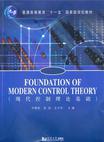现代控制理论基础
出版时间:2011-1 出版社:同济大学出版社 作者:许维胜,朱劲,王中杰 主编 页数:247
内容概要
本书第一部分,即线性系统的状态空间分析和综合,由许维胜教授负责编写。第二部分,即线性离散控制系统,由朱劲副教授编写。第三部分,即非线性系统,由王中杰教授编写。美国韦恩州立大学的林峰教授为本书提出了诸多宝贵的修改意见。同时,同济大学蒋平、姚静老师、易总根研究生等,也为本书的校对和修改做了大量的工作,在此对他们的贡献表示衷心的感谢。
书籍目录
Section Ⅰ State Space Analysis and Synthesis of Linear
Systems
1 State Space Description of Dynamic Systems
1.1 Introduction
1.2 State and state space
1.3 State space description of dynamic systems
1.4 Canonical form of SISO state space representation
1.4.1 Controllable canonical form
1.4.2 Observable canonical form
1.4.3 Diagonal form and Jordan canonical form
1.5 Some examples of developing state space descriptions
1.6 Equivalent state equations
1.6.1 Similarity transformation
1.6.2 An application of similarity transformation--Diagonal form
and Jordan form
1.7 Relationship between I/O description and
state-spacedescription
1.7.1 Transfer function from state-space description
1.7.2 State-space representations from transfer
functionsRealizations
Problems
2 Solution of State Equations of Linear Systems
2.1 Introduction
2.2 Solution of linear homogeneous state equation
2.3 Properties and calculations of the matrix exponential
function
2.3.1 Properties of □
2.3.2 Calculation of □
2.4 Solution of state equations
2.5 State transition matrix of linear time-invariant
systemsProblems
3 Controllability and Observability
3.1 Introduction
3.2 Controllability
3.2.1 Definition of complete state controllability
3.2.2 Controllability criterion for time-invariant systems with
arbitrary eigenvalues
3.2.3 Controllability criterion for time-invariant systems with
distinct □genvalues
3.2.4 Controllability criterions for time-invariant systems
withmulti-eigenvalues
3.3 Observability
3.3.1 Definition of complete state observability
3.3.2 Observability criterion for time-invariant systems with
arbitrary eigenvalues
3.3.3 Observability criterion for time-invariant systems with
distinct eigenvalues
3.3.4 Observability criterion for time-invariant systems with
multi-eigenvalues
3.4 Principle of duality
3.5 Obtaining the controllable and observable canonicalforms for
SISO systems
3.5.1 Controllable canonical form of SISO systems
3.5.2 Observable canonical form of SISO systems
3.6 Canonical decomposition
3.6.1 Decomposition according to controllability
3.6.2 Decomposition according to observability
3.6.3 Canonical structure of system
Extensions and Proofs
Problems
4 Desigh of State Feedback Control Systems
4.1 Introduction
4.2 State feedback
4.2.1 State feedback scheme
4 2 2 The effect of state feedback on system properties
4.3 Pole assignment using state feedback
4.3.1 Description of pole assignment problem
4.3.2 Necessary and sufficient condition for arbitrary pole
assignment
4.3 3 Pole assignment via control canonical form of state
equations
4.3.4 Pole assignment via Ackermann's formula
4.3.5 Direct calculation of gains by comparing characteristic
equations
4.4 Design of state observers
4.5 Feedback from estimated states
Problems
Section Ⅱ Linear Discrete-time Systems
5 Discrete-time Systems and Computer Control Systems
5.1 Introduction
5.2 Sample-data control and computer control systems
5.3 Related theories
?5.4 Sampling process and sample theorem
5.5 The z transform
5.6 The computation of z transform and the z transform of
elementary functions
5.7 Important properties of the z transform
5.8 The inverse z transform
5.9 Difference equation
5.10 The z transform method for solving difference
equations
5.11 The model of a discrete-time control system and the pulse
transfer function
5.12 The difference equation and pulse transfer function
Problems
6 Analysis and Design of Discrete-Time Control Systems
6.1 Introduction
6.2 Mapping between the s plane and the z plane
6.3 Stability analysis of closed-loop systems in the z
plane
6.4 Steady-state response analysis
6.5 The dynamic analysis for the control system in the z
plane
6.6 The design of the discrete-time compensator
6.6.1 Dead-beat control with intersampling ripples
6.6.2 Dead-beat control without intersampling ripples
6.6.3 Shortcomings of the Dead-beat control
6.7 Realization of digital controller
Problems
Section Ⅲ Nonlinear Systems
7 Introduction to Nonlinear Control Systems
7.1 Introduction
7.2 Common nonlinear elements
7.3 Properties of nonlinear systems
7.3.1 Classification of nonlinearities
7.3.2 Some common nonlinear system behaviors
7.4 Approaches to the analysis of nonlinear control systems
8 Describing Function Analysis
8.1 Introduction
8.2 Describing function fundamentals
8.2.1 Basic assumptions
8.2.2 Basic definitions
8.2.3 Computing describing functions
8.3 Describing functions of common nonlinearities
8.4 Describing function analysis of nonlinear system
8.4.1 Prediction and stability of self oscillations
8.4.2 Plot of curves of G(□) and -□
8.4.3 Reliability of the describing function method
8.5 Conclusion
Problems
9 Phase Plane Analysis
9.1 Introduction
9.2 Basic ideas of phase plane analysis
9.3 Characteristics of phase plane trajectories
9.4 Constructing phase portraits
9.4.1 The method of isoclines
9.4.2 Analytical method
9.5 Phase plane analysis of nonlinear systems
9.5.1 Linearization of nonlinear system
9.5.2 Phase trajectories for linear systems
9.6 Conclusions
Problems
10 Lyapunov Stability Theory
10.1 Introduction
10.2 Equilibrium states and concepts of stability
10.2.1 Equilibrium state
10.2.2 Concepts of lyapunov stability
10.3 Lyapunov's linearization method
10.4 Lyapunov's direct method
10.4.1 Basic idea
10.4.2 Some concepts of singular scalar functions
? 10.4.3 Lyapunov's stability theorems
10.5 Construction of Lyapunov function
10.5.1 Lyapunov equation
10.5.2 The variable gradient method (Schultz-Gilbson
method)
10.5.3 Aiserman method
10.6 Conclusions
Problems
References
图书封面
评论、评分、阅读与下载
用户评论 (总计8条)
- 内容丰富,简单易懂,适合初学者!
- 正版的,给老公读书用的,还不错
- 印刷质量不错,还没看
- 没想到是英文版的,不过全书比较浅显,应该很好理解吧
- 恍恍惚惚斤斤计较斤斤计较解决
- 书本有点旧,可能是快递不好吧,书都折了
- 大同小异,考同济的才买来看看,并未有出众的地方
- 中国式英文教材,中国人写的,比较好懂,但是很肤浅,适合选修课使用
